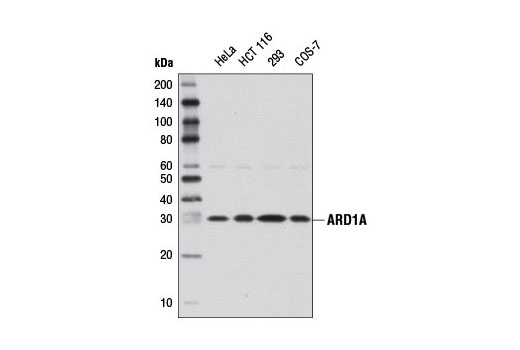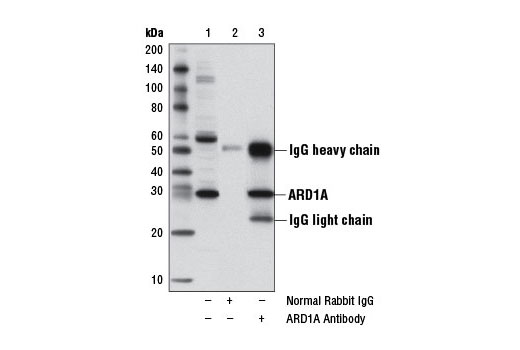WB, IP
H Mk
Endogenous
28
Rabbit
#P41227
8260
Product Information
Product Usage Information
| Application | Dilution |
|---|---|
| Western Blotting | 1:1000 |
| Immunoprecipitation | 1:50 |
Storage
Specificity / Sensitivity
Species Reactivity:
Human, Monkey
Source / Purification
Polyclonal antibodies are produced by immunizing animals with a synthetic peptide corresponding to residues surrounding Val171 of human ARD1A protein. Antibodies are purified by protein A and peptide affinity chromatography.
Background
Protein acetylation is a common modification that occurs both at lysine residues within proteins (ε-amino acetylation) and multiple amino acid residues at the amino terminus of proteins (α-amino acetylation). The N-α-acetyltransferase ARD1 homolog A protein (ARD1A, also known as NAA10) and the highly homologous N-α-acetyltransferase ARD1 homolog B protein (ARD1B, also known as ARD2 or NAA11) are mutually exclusive catalytic subunits of the amino-terminal acetyltransferase complex (NatA) (1-3). This complex, which consists of either ARD1A or ARD1B and the N-α-acetyltransferase 15 (NAA15) auxiliary protein, localizes to ribosomes where it functions to acetylate Ser-, Ala-, Gly-, Thr-, Cys-, Pro-, and Val- amino termini after initiator methionine cleavage during protein translation (1-5). Like ε-amino acetylation, amino-terminal α-amino acetylation functions to regulate protein stability, activity, cellular localization, and protein-protein interactions (4,5). Defects in ARD1A have been shown to cause amino-terminal acetyltransferase deficiency (NATD), which results in severe delays and defects in postnatal growth (6).
In addition to functioning as amino-terminal acetyltransferases in the NatA complex, free ARD1A and ARD1B proteins regulate cell growth and differentiation through ε-amino acetylation of lysine residues in multiple target proteins, including the HIF-1α, β-catenin, and AP-1 transcription factors (7-9). ARD1A-mediated acetylation of HIF-1α at Lys532 under normoxic conditions enhances binding of VHL, leading to increased ubiquitination and degradation of HIF-1α and down-regulation of HIF-1α target genes involved in angiogenesis, apoptosis, cellular proliferation, and glucose metabolism (7). Decreased expression of ARD1A under hypoxic conditions contributes to the stabilization of HIF-1α and upregulation of target genes (7). ARD1A also promotes cell proliferation and tumorigenesis by acetylating and activating β-catenin and AP-1 transcription factors, leading to the stimulation of cyclin D1 expression (8,9). Interestingly, the acetyltransferase activity of ARD1A is regulated by autoacetylation at Lys136, which is required for the ability of ARD1A to promote proliferation and tumorigenesis (9). Research studies have shown that ARD1 proteins are over-expressed in multiple cancers, including breast, prostate, lung, and colorectal cancers (10-13).
- Arnesen, T. et al. (2005) Biochem J 386, 433-43.
- Arnesen, T. et al. (2006) BMC Biochem 7, 13.
- Pang, A.L. et al. (2009) Biol Reprod 81, 302-9.
- Van Damme, P. et al. (2011) FEBS J 278, 3822-34.
- Polevoda, B. and Sherman, F. (2000) J Biol Chem 275, 36479-82.
- Rope, A.F. et al. (2011) Am J Hum Genet 89, 28-43.
- Jeong, J.W. et al. (2002) Cell 111, 709-20.
- Lim, J.H. et al. (2006) Cancer Res 66, 10677-82.
- Seo, J.H. et al. (2010) Cancer Res 70, 4422-32.
- Arnesen, T. et al. (2005) Thyroid 15, 1131-6.
- Ren, T. et al. (2008) Cancer Lett 264, 83-92.
- Yu, M. et al. (2009) Oncol Rep 21, 909-15.
- Yu, M. et al. (2009) Cancer Invest 27, 978-83.
Species Reactivity
Species reactivity is determined by testing in at least one approved application (e.g., western blot).
Western Blot Buffer
IMPORTANT: For western blots, incubate membrane with diluted primary antibody in 5% w/v BSA, 1X TBS, 0.1% Tween® 20 at 4°C with gentle shaking, overnight.
Applications Key
WB: Western Blotting IP: Immunoprecipitation
Cross-Reactivity Key
H: human M: mouse R: rat Hm: hamster Mk: monkey Vir: virus Mi: mink C: chicken Dm: D. melanogaster X: Xenopus Z: zebrafish B: bovine Dg: dog Pg: pig Sc: S. cerevisiae Ce: C. elegans Hr: horse GP: Guinea Pig Rab: rabbit All: all species expected
Trademarks and Patents
Limited Uses
Except as otherwise expressly agreed in a writing signed by a legally authorized representative of CST, the following terms apply to Products provided by CST, its affiliates or its distributors. Any Customer's terms and conditions that are in addition to, or different from, those contained herein, unless separately accepted in writing by a legally authorized representative of CST, are rejected and are of no force or effect.
Products are labeled with For Research Use Only or a similar labeling statement and have not been approved, cleared, or licensed by the FDA or other regulatory foreign or domestic entity, for any purpose. Customer shall not use any Product for any diagnostic or therapeutic purpose, or otherwise in any manner that conflicts with its labeling statement. Products sold or licensed by CST are provided for Customer as the end-user and solely for research and development uses. Any use of Product for diagnostic, prophylactic or therapeutic purposes, or any purchase of Product for resale (alone or as a component) or other commercial purpose, requires a separate license from CST. Customer shall (a) not sell, license, loan, donate or otherwise transfer or make available any Product to any third party, whether alone or in combination with other materials, or use the Products to manufacture any commercial products, (b) not copy, modify, reverse engineer, decompile, disassemble or otherwise attempt to discover the underlying structure or technology of the Products, or use the Products for the purpose of developing any products or services that would compete with CST products or services, (c) not alter or remove from the Products any trademarks, trade names, logos, patent or copyright notices or markings, (d) use the Products solely in accordance with CST Product Terms of Sale and any applicable documentation, and (e) comply with any license, terms of service or similar agreement with respect to any third party products or services used by Customer in connection with the Products.

